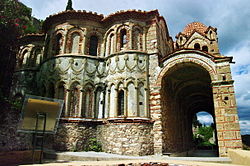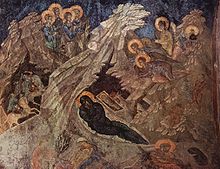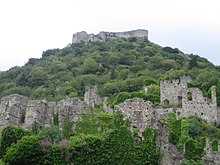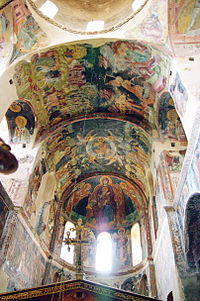| Mystras Μυστράς | |
 | |
Location  | |
| State | Greece |
|---|---|
| Region | Peloponnese |
| Territory | Laconia |
| Institutional website | |
Mystras is the archaeological site of a ruined city located in Laconia west of Sparta, on the edge of the Taygetos mountains. Late Byzantine buildings have been declared UNESCO World Heritage Site since 1989.
To know
Background

During the fourth crusade, theByzantine empire it was destroyed and dismembered. Several castles were built to protect this area, including the Mystras fortress on a hill 7 km from Sparta. The fortress was built in 1249 by the Frankish prince William of Villehardouin. When then in 1263 the crusaders had to return this fortress to the Byzantines, the emperor Michael VIII Palaeologus of kingdom of Morea he chose Mystras as his capital, making it also a thriving cultural center. In 1460, when the city was conquered by the Turks it was administered by the despots of the Morea, this did not prevent the cultural awakening so much that the neoplatonic Giorgio Gemisto Pletone founded a school of philosophy that attracted many scholars of the Byzantine world. Architecture and art also flourished, which can still be admired on site today.
After a period of decline with the Ottoman occupation, the Venetians arrived in 1687 and revived the city thanks to the silk trade. In 1715 the Turks returned, in 1770 first the Russians then the Albanians in 1780 and further looting emptied the center. During the Greek War of Independence, it was decided to leave the city and found a new city on the soil of ancient Sparta. You have to wait until the 1950s to see the center restored and declared a UNESCO World Heritage Site in 1989.
How to get
By bus
There are several daily connections between Mystras and Sparta except Sunday.
- 1 KTEL bus stop.
Permits / Rates
Two entrances are possible, both close to the parking lots.
- Entrance, ☎ 30 2731083377, 30 2731025363, fax: 30 2731083377, 30 2731025363.
 € 12 full, € 6 reduced. From 1st November to 31st March admission is reduced.
€ 12 full, € 6 reduced. From 1st November to 31st March admission is reduced.  From 1 November to 31 March: 8: 00-15: 00, from 1 April to 31 August: 08: 00-20: 00, from 1 to 30 September: 08: 00-19: 00, from 1 to 31 October: 08: 00-18: 30.
From 1 November to 31 March: 8: 00-15: 00, from 1 April to 31 August: 08: 00-20: 00, from 1 to 30 September: 08: 00-19: 00, from 1 to 31 October: 08: 00-18: 30.
How to get around

In order to visit the area it is necessary to leave the car in the two car parks:
- 2 Upper parking
- 3 Lower parking
The lower car park fills up easily with cars and buses, consider visiting early or on less crowded days. The visit to the site involves the need to face some climbs and a series of stairs, as the site is steeply sloping.
What see
Lower town

- 1 Agios Demitrios Cathedral (Mitropolis Hagios Demetrios). The cathedral is dedicated to the holy soldier Demetrios, and is the oldest church in Mystras. Its architectural history comes from an inscription on the south wall, dated 1291/92. The church was founded by Bishop Nikophoros Moschopoulos, Metropolitan of Laconia, based in Mystras. The construction of the thirteenth / fourteenth century was a three-nave basilica with a wooden ceiling. At the beginning of the 15th century an upper floor in the shape of a cross with central and corner domes was added to the nave of the basilica. A tribune with side galleries was erected above the narthex (portico). Here the ladies of the court could participate in the service. The two construction periods are clearly distinguishable from the outside. The tower and the portico to the east date from the 15th century. During the reconstruction, the previous frescoes were partially destroyed. In the central nave there are scenes from the life of Christ, in the left aisle scenes from the life of St. Demetrios and in the right aisle the life of Mary. In the apse of the Blessed Sacrament there is a representation of the Virgin Mary with the child, in the diaconicon (room to the side of the main apse) the Trinity and representations of the Last Judgment and ecumenical councils. In the floor there is a stone bas-relief with the double-headed eagle, the coat of arms of the Byzantine emperors, in memory of the coronation of the Byzantine emperor Constantine XI. The cult of Demetrios comes from the Crusaders, who worshiped Demetrius as a helper in battles.
- 2 Archaeological Museum of Mystras.

- 3 Convent of Pantanassa. The convent is still inhabited by the nuns who offer embroidery and other souvenirs for sale. It was built in 1365 by Manuel Kantakuzenos and enlarged in 1428 by Johannes Frankopulos, the minister of the despot Konstantin XI. The Katholikon of the convent is particularly well preserved and is considered the most beautiful church in Mystras. Under the windows on the western side is the monogram of the founder John Frankopoulos. The church has a main dome in the center of the church, in addition there are smaller domes at the corners with cross arches, a high dome above the narthex gallery and a three-story tower. The so-called "pseudocufic" relief decoration of the front door is based on Islamic prototypes, while the blind arches point to the outer sides and the western-influenced bell tower. The frescoes from the church's original period are partially preserved. In the dome we find the Christ Pantocrator among the four Evangelists and various frescoes. The frescoes in the upper part of the dome date back to the 15th century. The iconostasis is also interesting.
- You will notice the presence of numerous pieces of paper on the left side attached by the faithful as thanks or as a miraculous intercession of the icon.


- 4 Perivleptos Monastery. An excellent example of the art of the first despot of Mystras. The monastery was built before 1350 as Katholikon (main church) and is located in the steep rocky slope on the western city wall. A tower structure with an unusual plan in the shape of a parallelogram has been preserved from this church. Inside, the extraordinary height of the arms is particularly remarkable. In a cave on the west side there is a chapel dedicated to Saint Catherine. The fresco decoration in the eastern transept and in the dome is particularly well preserved. In the main apse, the enthroned Madonna is depicted with angels, including the Lord's Supper. On the walls of the Hieron the sacrament is depicted above the transfiguration of Christ. In the dome we find the image of the Pantocrator on eight decorated pillars, among which the prophets, Mary among the angels and the preparation of the throne of Christ are depicted. These frescoes are among the highlights of medieval church painting in Greece.

- 5 Evangelistria church. Evangelistria is the only church in Mystras for which no information about its founder is available. It seems, however, that the Turks never turned it into a mosque, according to the graffiti that can be seen on its walls. One can read, "Nikiephoros, monk priest of Athens, 1633", or, dating back to 1711, "Grigorios, priest monk, took the Ach ...". On the north wall, a 15th-century inscription has the name of Sphrantzès, but nothing indicates that it is the historian Georges Sphrantzès. The interior sculptures are notable for their unity of style, which suggests that they were specially designed for this church. Only the style of the sculptures allows a possible dating of the building: probably from the end of the 14th century or the beginning of the 15th century.
Vrontochion Monastery
Vrontochion Monastery consists of two churches: the Church of Odiyitria-Aphentiko and Hagia Theodori.

- 6 Odiyitria-Aphentiko Church. On the north side of the city hill we find the Hagia Theodori church (late 13th century) and the Odogitria church, which is also commonly called "Afendiko" (Church of the sovereigns). In the monastery, the refectory has a barrel vault, and a kitchen and accommodation are well preserved. This church connects the three-nave basilica types with the gallery and cross church. The building was initially designed as a domed church, the plan was changed so that the church received the character of a basilica. Galleries were erected above the nave arches and a central loggia for the despot above the narthex (vestibule). Upstairs, the impression of a domed church with a central dome and four smaller domes in the corners has been preserved. The frescoes in the church are badly damaged. In the eastern vaults there are scenes of the ascension of Christ, the saints in the corridors, in the narthex the miracles of Christ, in the right arm the baptism of the cross of Christ and in the dome of the west gallery, the Mother of God with Christ, prophets and figures of the Old Testament. In the north side chapel is the tomb of the despot Theodore II. Palaiologos (died 1444), with his portraits as a despot and, as a monk in the calender and the archimandrites Pachomos in a fresco on whose knee shows the model of the church of the Madonna.


- 7 Church of San Teodoro (Hagia Theodori church). Two holy warriors are dedicated, General Theodor Stratelares (military commander) and San Teodoro Tiro. It was probably originally the Katholikon and later the funerary church of the Vrontochion monastery. It was built before 1296 by the archimandrite Pachomios. The church has a square central room with a large dome. In the outer corners of the arms of the cross there are the funerary chapels of the abbots. The model of the building was the church of Santa Sofia a Monemvasia and the church of the Daphni monastery, which is much larger. The frescoes of the construction period are severely damaged, on the pillars of the lower wall there are representations of the holy warriors.
High City


- 8 Villehardouin Castle (Kastro). The fortress is the heart of the defense of Mystras. Built in 1249 by William II of Villehardouin, then improved by the Byzantines and the Turks, it develops on the top of the hill, dominating the entire valley. There is only one door that allows access to the citadel and it is defended by a square tower. The citadel is a relatively flat space defended by two bastions, one external and one internal. Once we have crossed the external enclosure, we arrive at the lowest part, but also the widest. There are ruins of houses dating back to the Ottoman period. At the southeast end of the bastion a watchtower was built from which both the plain of Sparta and the slopes of Taygetus can be observed. On this side, the citadel was inaccessible and almost invulnerable.
- The internal enclosure surrounds the northwestern part of the citadel. It housed a building used as a residence for subsequent governors and a chapel. This building would be the oldest building in Mystras, as it was built before the arrival of the Franks. As in the east, the western end served as a lookout tower to monitor the western slopes of Taygetos.

- 9 Agia Sofia (Hagia Sophia). The church was built around 1360, by order of the despot Manuel II. Christos Zoodotos (Life-giving Christ) was consecrated and later renamed Hagia Sophia (Holy Wisdom). The architecture corresponds to the church of Panaghia Perivleptos with a basilica dome. We also find the monuments of the founders and the coats of arms of Manuel Kantakuzenos with the double-headed eagle. The dome depicts God the Father, under whom there is a mosaic on the floor, interpreted as omphalos (navel of the world). The north portico served as the entrance to the despot, and there is a chapel of the Madonna with the image of Panagia as an intercessor in the apse. The three-story bell tower to the west is followed by the despot's family cemetery. The Haghia Sophia was the only church in Mystras, which served as a mosque in the Turkish period.
.jpg/220px-Despot's_Palace_(Mystras,_Greece,_2017).jpg)
- 10 Despot's Palace. The Despot's Palace was the residence of the Byzantine governors (the despots in fact). The building has an L-shaped plan with parts built between the mid-twelfth and the end of the fourteenth century. The three-storey outer walls are preserved, while the Franks' "City Palace" forms the south-east wing of the building. The palace was enlarged around 1348 with the arrival of the despot Manuel Kantakuzenos. He built a residential building connected to the old French building. The despot's residence had six large rooms on two floors. On the side of the valley, a porticoed terrace has been added, from which a wide view of the Eurata valley opens up. In the eastern part of the residential section there is a chapel and a high defense tower. In the following years, it was enlarged with the construction of the throne room. It had rectangular windows with Gothic ornamental frames and six round skylights. The place where the despot's throne stood was highlighted by a stained glass window and crowned with the double-headed eagle as a symbol of the paleontologists in power. The palace also became the home of the Turkish governor of Mystras.
- 11 Church of San Nicola (Agios Nikolaos). Built in the Ottoman era, with 18th century frescoes.
- 12 Porta Monemvasia. This door distinguishes the upper from the lower part of the Mystras site.
- 13 Gate of Nafplio.
Other monuments
- 14 Statue of Konstantinos XI Palaiologos, Plateía Mystrás.
What to do
Shopping
Where to eat
In the lower part of Mystras there is a modern cluster of houses full of restaurants and bars.
- 1 το Καφε Νέον. Recently opened bar on the square.
Where stay
- 1 Castle View Camping, ☎ 30 27310 83303, fax: 30 27310 20028.
- 2 Paleologio Camping, ☎ 30 27310 22724, 30 6980125014 (mobile phone).
- 3 Byzantion Hotel, ☎ 30 2731 083309.
- 4 Mazaraki Guesthouse, Pikoulianika village, ☎ 30 2731 020414, @[email protected].
Safety
The visit to the site must however be addressed with suitable clothing, comfortable shoes and sportswear. The walk often moves on rough terrain.
How to keep in touch
Around
Sparta is the nearest town and is only 7 km away.









.jpg/200px-Fresken_(25460956521).jpg)







